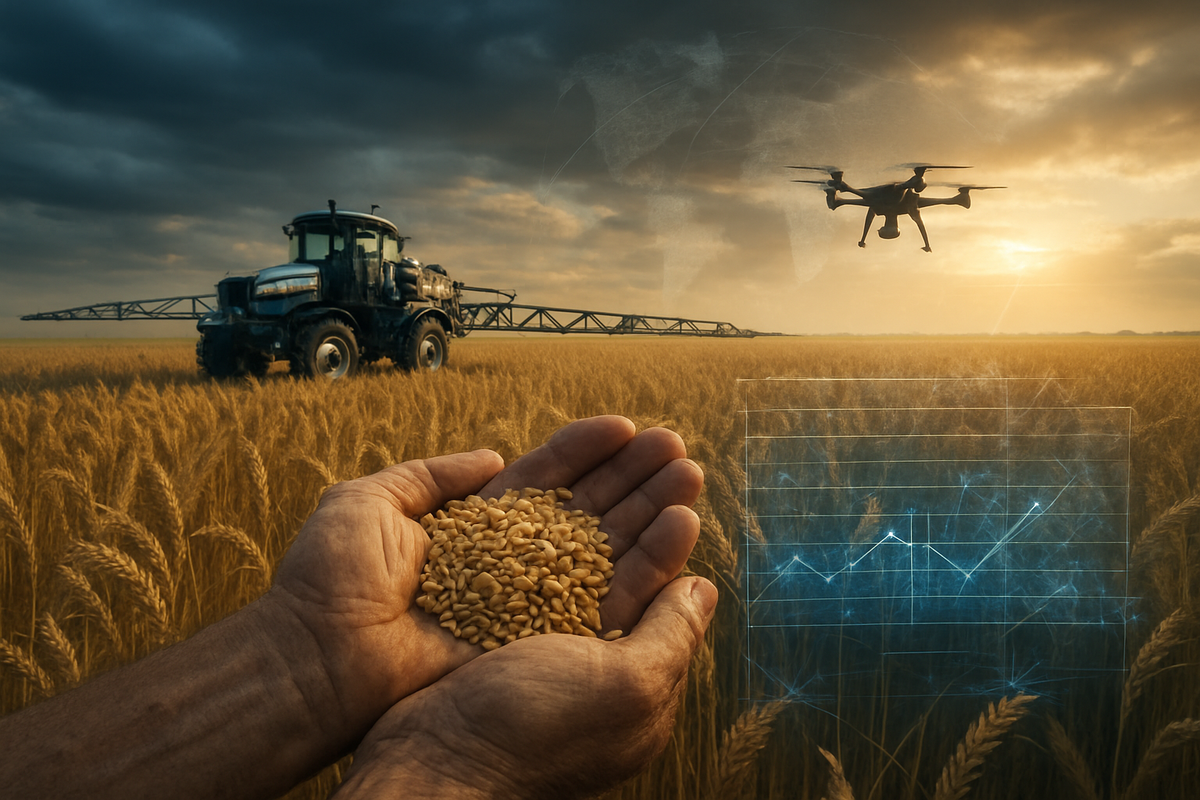
The global wheat market in late 2025 presents a formidable landscape for farmers, characterized by a challenging confluence of persistent price volatility, stubbornly high input costs, and a complex web of geopolitical influences. While some forecasts suggest a potential increase in global wheat stocks for the 2025/26 marketing year, offering a glimmer of hope, the immediate reality for many growers is a "cost-price squeeze" that threatens profitability and long-term sustainability. This environment underscores an urgent need for wheat farmers to adopt effective cost-cutting measures and robust risk management strategies to weather the storm and secure their financial future.
Economists and agricultural experts are increasingly emphasizing proactive financial stewardship, operational efficiencies, and strategic market engagement as critical tools for survival and success. With production expenses projected to reach record levels and farm sector debt continuing to climb, the ability of farmers to adapt to these volatile conditions by meticulously managing their expenditures and mitigating market risks will be paramount. This article delves into expert recommendations, outlining practical steps wheat farmers can take to enhance resilience in the current global marketplace.
Strategic Cost-Cutting and Robust Risk Management: A Farmer's Blueprint
The current economic climate demands a multi-faceted approach to farm management, integrating both stringent cost control and sophisticated risk mitigation. Economist insights highlight several key areas where wheat farmers can make significant strides.
One primary area for cost reduction lies in input optimization. Farmers are urged to meticulously analyze their fertilizer, pesticide, and seed usage. This involves conducting regular soil tests to ensure precise nutrient application, avoiding over-fertilization which not only wastes money but can harm the environment. Utilizing precision agriculture technologies, such as variable-rate application (VRA) for inputs, can lead to substantial savings by applying exactly what is needed, where it is needed. Furthermore, exploring bulk purchasing options or forward contracting for inputs when prices are favorable can lock in lower costs. The rising cost of fuel necessitates efficient machinery use, proper maintenance, and route optimization to minimize consumption. Labor costs, which have seen a significant jump, can be managed through improved operational efficiency, automation where feasible, and careful scheduling.
Technology adoption extends beyond precision agriculture to encompass a broader range of tools that can enhance efficiency and reduce waste. Drones for field scouting, advanced irrigation systems that conserve water and energy, and farm management software that provides data-driven insights for decision-making are becoming increasingly vital. While these may represent initial capital expenditures, economists argue that the long-term return on investment through reduced input costs, improved yields, and better resource management often outweighs the upfront cost. Companies like Deere & Company (NYSE: DE) and Trimble Inc. (NASDAQ: TRMB) are at the forefront of providing such technologies, offering solutions that promise greater operational efficiency.
For risk management, diversification of crops or farm activities can buffer against price fluctuations in a single commodity. While this article focuses on wheat, considering complementary crops can spread risk. More directly, financial hedging strategies are crucial. This involves using futures and options contracts on commodity exchanges (e.g., Chicago Board of Trade, CBOT) to lock in a price for a portion of the anticipated harvest. While complex, working with agricultural financial advisors or brokers can help farmers understand and implement these strategies effectively, protecting against sharp price declines. Crop insurance remains a fundamental safety net, guarding against yield losses due to adverse weather or other unforeseen events. Given the increasing frequency of extreme weather patterns, robust crop insurance coverage is more critical than ever. Furthermore, maintaining adequate working capital and establishing strong relationships with lenders can provide financial flexibility during challenging periods, especially with interest rates for farm operating loans nearly double their 2021 levels.
Market Dynamics and Corporate Engagement
The current market environment, characterized by both supply uncertainties and downward price pressures in some forecasts, creates a complex landscape for public companies operating in the agricultural sector. Companies that provide solutions for efficiency and risk mitigation stand to gain, while those heavily reliant on high commodity prices or traditional, less efficient farming practices may face headwinds.
Agricultural technology companies are poised to be significant beneficiaries. Firms specializing in precision agriculture, such as Raven Industries (a subsidiary of CNH Industrial N.V., NYSE: CNHI), AGCO Corporation (NYSE: AGCO), and Lindsay Corporation (NYSE: LNN), which manufactures irrigation systems, will likely see increased demand for their products and services as farmers seek to optimize input usage and improve yields. Their ability to deliver solutions that directly address the "cost-price squeeze" makes them attractive partners for farmers. Similarly, seed and chemical companies like Corteva Agriscience (NYSE: CTVA) and Bayer AG (ETR: BAYN) that offer high-performing, resilient crop varieties and efficient crop protection products will also find a strong market, provided their offerings contribute to overall cost-effectiveness for farmers.
Conversely, companies involved in sectors that may experience reduced demand due to farmer austerity could face challenges. For instance, manufacturers of large, non-essential farm machinery might see a slowdown in sales as farmers delay capital expenditures. Highly leveraged agricultural input suppliers who cannot offer competitive pricing or value-added services may also struggle if farmers aggressively seek cheaper alternatives or reduce overall input consumption. The financial institutions providing farm loans, such as AgriBank (a cooperative bank within the Farm Credit System) or regional banks with significant agricultural portfolios, will need to carefully manage their exposure to the rising farm debt and potential defaults, especially if the cost-price squeeze intensifies and government support, currently a significant factor in net farm income, does not keep pace. Their "win" or "loss" will depend on their risk assessment and portfolio management strategies in this volatile environment.
Broader Significance and Industry Transformation
The emphasis on cost-cutting and risk management for wheat farmers is not an isolated event but rather a critical component of broader industry trends shaping the future of agriculture. This push towards efficiency and resilience is a direct response to a confluence of factors including climate change impacts, increasing global food demand, geopolitical instability, and evolving consumer preferences.
The drive for precision agriculture and sustainable practices is accelerating. Farmers are not only looking to cut costs but also to enhance environmental stewardship, often driven by consumer demand and potential future regulations. This trend aligns with the United Nations' Sustainable Development Goals and initiatives from organizations like the Food and Agriculture Organization (FAO), pushing for more resource-efficient food production systems. The current economic pressures are effectively forcing a faster adoption of these practices.
Regulatory and policy implications are significant. The challenges faced by farmers are likely to influence discussions around the 2025 Farm Bill in the United States, with increased advocacy for enhanced safety nets, more robust crop insurance programs, and potentially subsidies or incentives for adopting sustainable and efficient technologies. Similar policy debates are occurring in the European Union (e.g., Common Agricultural Policy) and other major agricultural regions. Governments are increasingly recognizing the strategic importance of a stable and resilient agricultural sector for national food security.
Historically, periods of high input costs and volatile commodity prices have often led to consolidation within the agricultural sector. Smaller, less capitalized farms may find it difficult to compete, potentially leading to increased land concentration among larger, more efficient operations. This was observed during various agricultural downturns in the 20th century. However, the rise of niche markets, direct-to-consumer sales, and value-added processing could offer alternative pathways for smaller farms that strategically adapt. The current situation could also spur innovation in cooperative models, allowing farmers to pool resources for purchasing, marketing, and risk management.
The Path Forward: Adaptation and Innovation
The coming months and years will demand strategic pivots and continuous adaptation from wheat farmers. Short-term possibilities include a continued focus on optimizing current operations, delaying non-essential capital expenditures, and actively engaging in market hedging. Farmers will need to stay abreast of real-time market data, weather forecasts, and geopolitical developments to make agile decisions.
In the long term, the agricultural landscape will likely see an accelerated shift towards data-driven farming. The integration of artificial intelligence (AI) and machine learning (ML) in predicting yields, optimizing planting and harvesting schedules, and managing pests and diseases will become more commonplace. This presents both opportunities and challenges: opportunities for those who embrace these technologies to achieve unprecedented efficiencies, and challenges for those who lack access or expertise. Vertical integration or participation in value chains that offer more stable pricing (e.g., contract farming with food processors) could also emerge as a more widespread strategy to mitigate price volatility.
Market opportunities may arise for farmers who can differentiate their product through sustainable certifications, organic production, or specialty wheat varieties that command premium prices. Challenges will include navigating increasingly complex global trade dynamics, adapting to stricter environmental regulations, and managing the ongoing labor shortages. Potential scenarios range from a continued squeeze on profitability leading to further industry consolidation, to a more resilient and technologically advanced agricultural sector emerging from these pressures, capable of producing food more efficiently and sustainably.
Conclusion: Resilience in a Dynamic Market
The current global marketplace presents significant hurdles for wheat farmers, yet it also underscores the critical importance of proactive management. The key takeaways from economist insights are clear: meticulous cost control, particularly in input usage, and robust risk management strategies are no longer optional but essential for survival and prosperity. Embracing precision agriculture, exploring financial hedging tools, and maintaining strong financial health are foundational elements for building resilience.
Moving forward, the market will continue to be influenced by geopolitical events, climate patterns, and global demand shifts. Investors and stakeholders should closely watch for developments in agricultural policy, particularly the specifics of future farm bills and international trade agreements, as these will significantly impact the operating environment for farmers. The adoption rates of new agricultural technologies and the financial health indicators of farm communities will also serve as crucial barometers.
Ultimately, the wheat farming community is at a pivotal juncture. While the pressures are immense, the emphasis on innovation, efficiency, and strategic planning offers a pathway to not only navigate the current challenges but also to forge a more sustainable and profitable future for one of the world's most vital agricultural commodities.
This content is intended for informational purposes only and is not financial advice





